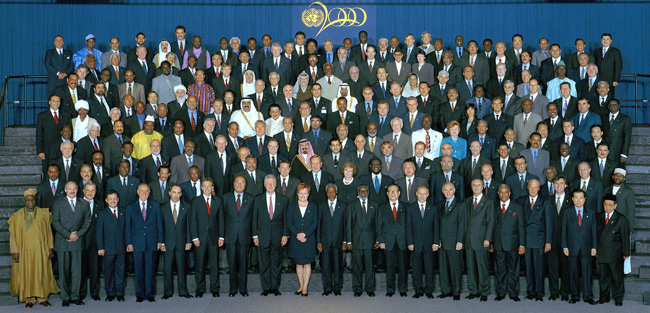Past Conferences, Meetings and Events > Millennium Summit
Millennium Summit (6-8 September 2000)

The United Nations Millennium Summit brought together 149 Heads of State and Government and high-ranking officials from over 40 other countries. UN Photo/ Terry Deglau (Eastman Kodak)
The General Assembly, by its resolution 53/202 of 17 December 1998, decided to designate the fifty-fifth session of the General Assembly “The Millennium Assembly of the United Nations”, and to convene, as an integral part of the Millennium Assembly, a Millennium Summit of the United Nations.
The Millennium Summit was held from Wednesday, 6 September, to Friday, 8 September 2000 at United Nations Headquarters in New York. In attendance were 149 Heads of State and Government and high-ranking officials from over 40 other countries.
The main document, unanimously adopted, was the Millennium Declaration, which contained a statement of values, principles and objectives for the international agenda for the twenty-first century. It also set deadlines for many collective actions.
The Millennium Declaration affirmed Member States' faith in the United Nations and its Charter as indispensable for a more peaceful, prosperous and just world. The collective responsibility of the governments of the world to uphold human dignity, equality and equity is recognized, as is the duty of world leaders to all people, and especially children and the most vulnerable.
The leaders declared that the central challenge of today is to ensure that globalization becomes a positive force for all, acknowledging that at present both its benefits and its costs are unequally shared. The Declaration called for global policies and measures, corresponding to the needs of developing countries and economies in transition.
Citing freedom, equality (of individuals and nations), solidarity, tolerance, respect for nature and shared responsibility as six values fundamental to international relations for the twenty-first century, the Summit
also identifies concrete objectives under broad headings that participants believe would lead to the desired outcomes.
Among the objectives with the declared aim of promoting peace, security and disarmament, world leaders resolved to strengthen the rule of law and ensure compliance with decisions of the International Court of Justice, to provide the United Nations with the resources it needs for conflict prevention and peaceful resolution of disputes, and to take action against the international drug problem and terrorism.
World leaders also made commitments to minimize the adverse effects of economic sanctions on innocent populations and to subject sanctions regimes to regular review, to urge constructive action on disarmament and to strengthen cooperation between the United Nations and regional organizations. The document also called on Member States to eliminate weapons of mass destruction, particularly nuclear weapons, and to keep all options open for this aim, including the possibility of convening an international conference to identify ways of eliminating nuclear dangers.
The world leaders who gathered at the Summit committed their nations to a new global partnership to reduce extreme poverty, and set out a series of time-bound targets, with a deadline of 2015, that have become known, since the Millennium Summit, as the Millennium Development Goals.
The Millennium Development Goals are to: (1) eradicate extreme poverty and hunger; (2) achieve uniersal primary education; (3) promote gender equality and empower women; (4) reduce child mortality; (5) improve maternal health; (6) combat HIV/AIDS, malaria and other diseases; (7) ensure environmental sustainability; and (8) develop a global partenership for development.
On environmental protection, the Millennium Declaration stated that no efforts must be spared to counter the threat of the planet being irredeemably spoiled by human activities. Therefore, the participants of the Summit resolved to adopt a new ethic of conservation and stewardship.
To strengthen the United Nations, Summit leaders resolved to reaffirm the central position of the United Nations General Assembly; intensify efforts for a comprehensive reform of the Security Council in all its aspects; further strengthen the Economic and Social Council and the International Court of Justice; encourage regular consultations and coordination among the Organization's principal organs; ensure greater policy coherence and urge the Secretariat to make the best use of resources, which should be provided on a timely and predictable basis.